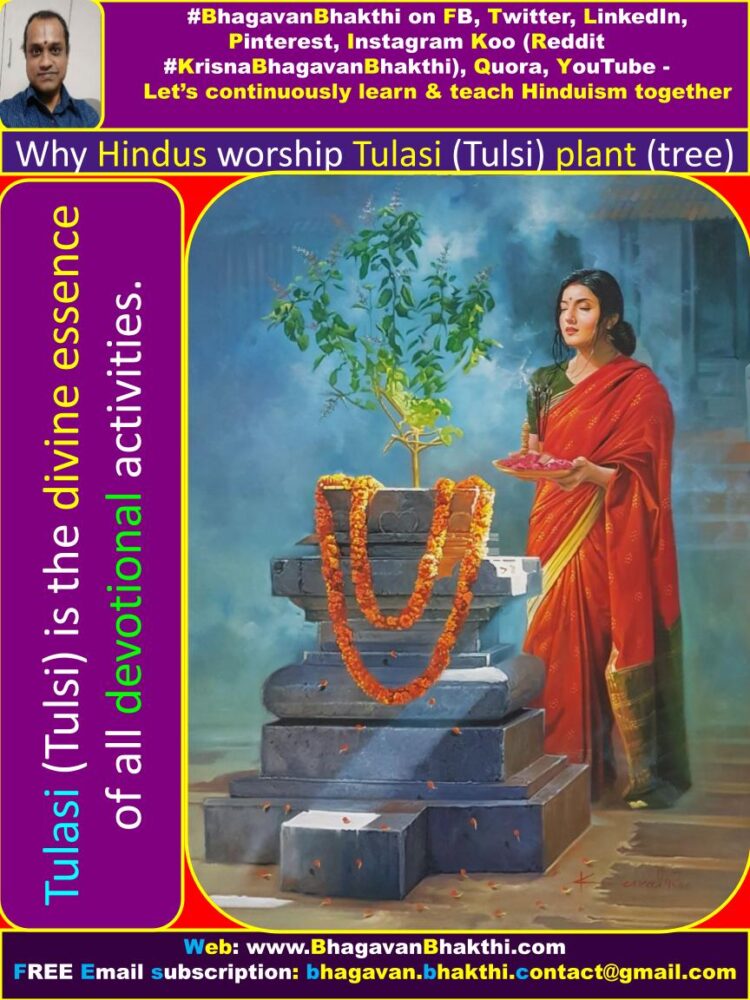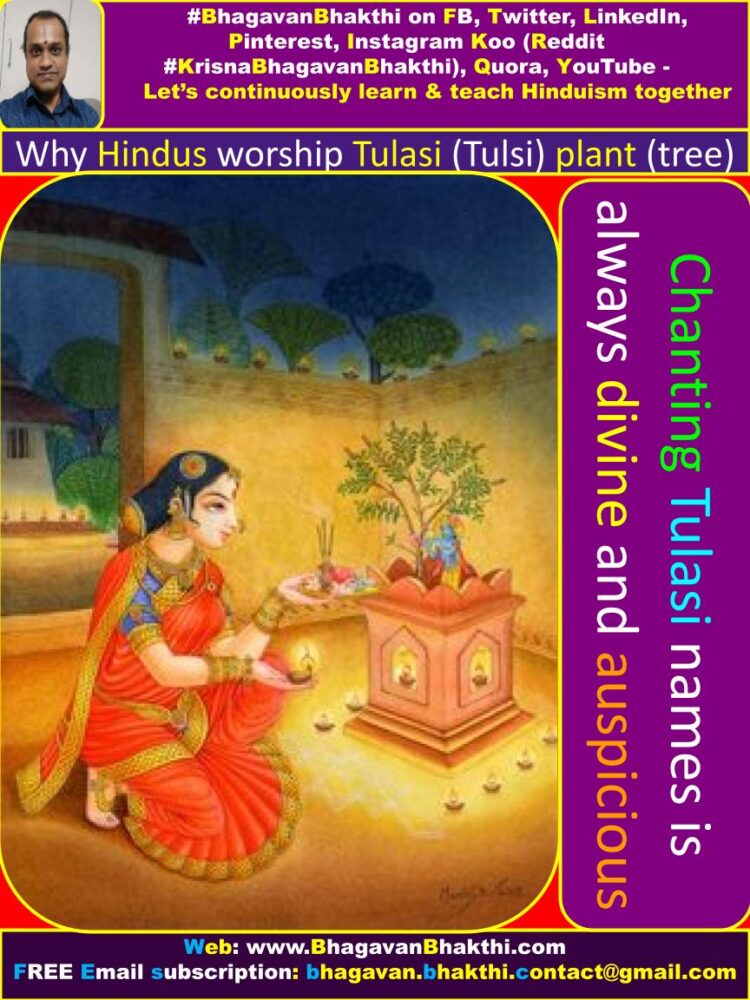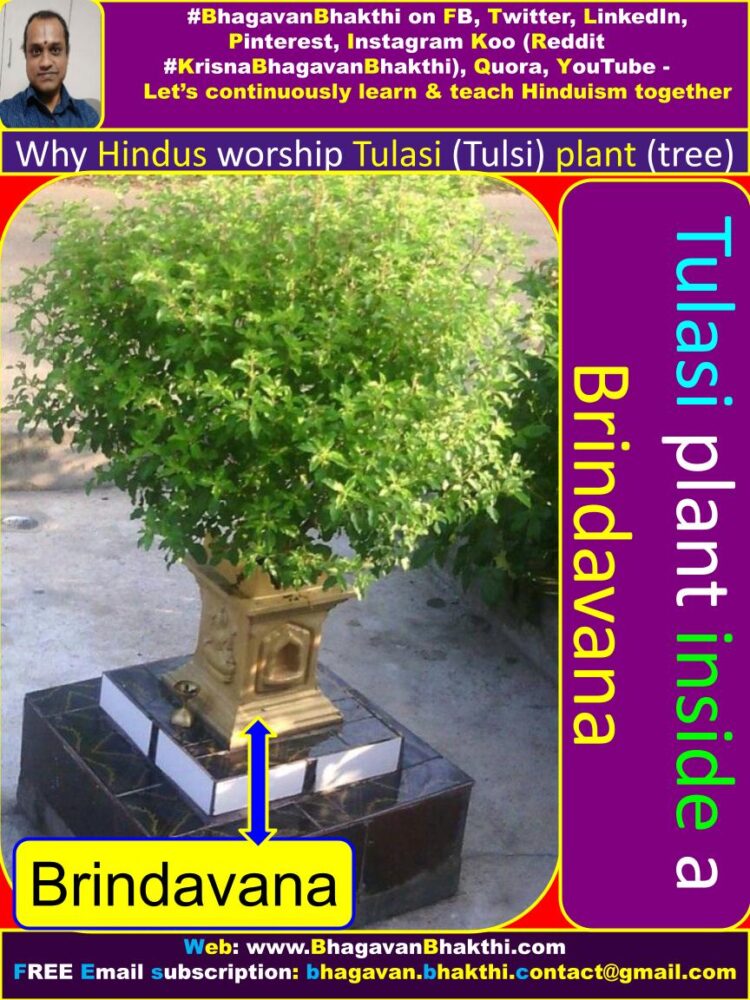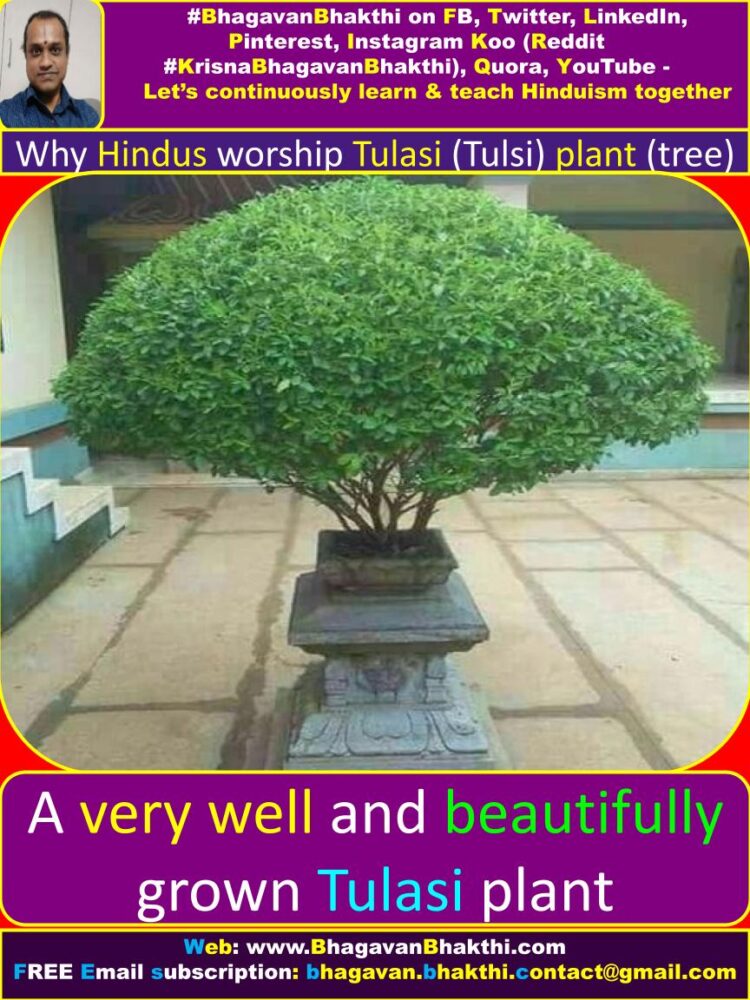Why Hindus worship Tulasi (Tulsi, basil) plant (tree) | Why Tulasi (Tulsi) plant is sacred for Hindus (Hinduism)? | Tulsi goddess story | Significance of Tulsi plant in Hinduism | Why do we worship Tulsi plant scientific reason | Benefits of worshipping Tulsi plant | Significance of Tulsi plant at home | How to worship Tulsi plant at home
Namaste friends, how are you doing today? Welcome to #BhagavanBhakthi website / blog.
Bhagavan Lord Sri Vishnu (Krishna, Rama, Trivikrama, Narasimha, Vamana, Vasudeva, Mukunda), Goddess Lakshmi (Rukmini, Satyabhama, Sita, Kamala, Maya) and Goddess Sri Tulasi Devi (Tulsi) blessings to you and your family!
In this website / blog, you will always learn about #Hinduism #Sanskrit language.
Also subscribe to my YouTube channel from this link #BhagavanBhakthi to view videos about #Hinduism #Sanskrit language.
Just before moving towards to know about “Why Hindus worship Tulasi (Tulsi, basil) plant (tree) | Why Tulasi (Tulsi) plant is sacred for Hindus (Hinduism)? | Tulsi goddess story | Significance of Tulsi plant in Hinduism | Why do we worship Tulsi plant scientific reason | Benefits of worshipping Tulsi plant | Significance of Tulsi plant at home | How to worship Tulsi plant at home“, let us know few basic and important information.

Significance of Tulasi (Tulsi) (basil) plant is as given below:
“Each and every house with a divine Tulasi (Tulsi) plant is a place of divine pilgrimage.” “In these houses there won’t be any diseases, no messenger(s) of Lord Sri Yama Deva (God of Death) can enter.” This is said in Skanda purana, Padma Purana – Uttarakhanda.
Also in our Shastras (Hindu Texts) it said that: “tulanaa naasti athaiva tulsi“. Meaning of this shloka is as given below: Tulasi is the one which is incomparable (in all its qualities).
The divine Srimad Bhagavatam tells the special position of the divine Tulasi (Tulsi) plant.
“Although flower producing plants like the mandara, kunda, kurabaka, utpala, champaka, arna, punnaga, nagakesara, bakula, lily, and parijata are full of transcendental fragrance, they are still conscious of the austerities performed by Tulasi.”
“Tulasi is given highly special preference by the Bhagavan Sri Hari, who always garlands Himself with Tulasi leaves.”

Tulasi (Tulsi) is the divine essence of all devotional activities. The leaves, flowers, roots, bark, branches, trunk, and shade of Tulasi plant (Tulasi Devi) are all divinely spiritual in all respect.
A house where Tulasi Devi (Tulasi plant) is present never falls on bad times, and it becomes purer than all holy places. The fragrance of Tulasi Devi (Talasi plant) purifies all who smell it.
One who sees or comes near a house or garden where the Tulasi plant is present, gets rid of all his sinful reactions, including that of killing a brahmana (Brahma hatya). Lord Sri Krishna happily lives in the house, town, or forest where Tulasi Devi (Tulasi plant) is present.

A recent research about the Tulasi (Tulsi) plant indicates the following:
1. Tulasi prevents gastric ulcers, 2. Tulasi reduces inflammation, 3. Tualsi lowers fevers, 4. Tulasi protects against radiation, 5. Tulasi reduces cholesterol, 6. Tulasi decreases high blood pressure,
7. Tulasi enhances periodontal health, 8. Tulasi displays significant natural antibacterial, antiviral and antifungal activity,
9. Tulasi improves digestion and absorption of other nutrients, 10. Tulasi even repels mosquitoes and other potentially harmful insects, etc.
[All these are very much said in our Shastras (Hindu Texts) and were always known by the ancestors unlike today’s so called modernized people.]

यन्मूले सर्वतीर्थानि एनमध्ये सर्वदेवताः | यदग्रे सर्व वेदाश्च तुलसितवां नमाम्यहं ||
ಯನ್ಮೂಲೇ ಸರ್ವತೀರ್ಥಾನಿ ಯನ್ಮಧ್ಯೇ ಸರ್ವದೇವತಾಃ | ಯದಗ್ರೇ ಸರ್ವ ವೇದಾಶ್ಚ ತುಲಸಿತ್ವಾಂ ನಮಾಮ್ಯಹಂ ||
yanmūlē sarvatīrthāni yanmadhyē sarvadēvatāḥ | yadagrē sarva vēdāśca tulasitvāṁ namāmyahaṁ ||
Meaning of this shloka is as given here: I bow down to the Tulasi (Tulsi), at whose base are all the holy pilgrimage places, at whose top reside all the deities and in whose middle are all the Vedas.
Using following, Tulasi Archana (Pooja / Worship) (Chanting of Tulasi names) can be done:
1. Sri Tulasyai Namah, 2. Sri Vishnu Pathniyai Namah, 3. Sri Aaga Handharyai Namah, 4. Sri Loka Vandhithayai Namah,
5. Sri Peethambara Dharinyai Namah, 6. Sri Ksheerabthi Thanayai Namah, 7. Sri Loka Jananyai Namah, 8. Sri Sarvaabharana Bhooshithaiyai Namah,
9. Sri Sumukayai Namah, 10. Sri Sunasikayai Namah, 11. Sri Ramayai Namah, 12. Sri Tulasyai Namah

Other significance of Tulasi (Tulsi) plant is as given here: Lord Sri Krishna will permanently reside wherever Tulasi (Tulsi) plant, pond (Pushkarni) with lotus flowers and Vaishnavas reside.
Goddess Sri Tulasi (Tulsi) Devi background information is as given here: Tulasi Devi took her birth on the Earth as the daughter of King Dharmadhwaja.
Tulasi Devi in the divine human form was an epitome of divine beauty and was blessed with an amsha (divine part) of Goddess Sri Lakshmi Devi. The king Dharmadhwaja, gave her the appropriate name of Tulasi (तुळसी) (tuḷasī).
Tulasi name meaning is as given here: In Sanskrit ‘Tula‘ means equal, meaning equal to Goddess Sri Lakshmi Devi. (But, nowhere is it said that Tulasi herself is Goddess Sri Lakshmi Devi.)
Lord Sri Vishnu (Sri Rama / Sri Krishna and his different avatars and forms) always wear the garland of Tulasi (Tulsi) to fulfil Tulasi’s desire to be always in the company of Lord Sri Vishnu.

Lord Sri Vishnu also gave a boon to Tulasi that “Tulasi will attain the company of himself (Lord Sri Vishnu) through the Tulasi dala (a bunch of Tulasi leaves formed at the end of the branch) given by all his (Lord Sri Vishnu) devotees (Vaishnavas)“.
Information about the avatar of Tulasi (Tulsi) Devi is as given below:
During the Mahabharata period, Jambavati Devi is the best (shreshta) among the six great women of Lord Sri Krishna.
[Here six great women means, shanmahishis (6 consorts) – other than Sri Rukmini Devi and Sri Satyabhama Devi, who were the avatars of Goddess Sri Lakshmi Devi.]
Goddess Sri Lakshmi Devi is present in a divine special form (vishesha sannidhana) in Tulasi Devi.
Jnanis (gyanis) (divinely learned persons) say that, it is Jambavati in the form of Tulasi, who is worshipping Lord Sri Vishnu on a daily basis (tuLasee jAmbavatee prOktA). This means, Sri Jambavati Devi (consort of Lord Sri Krishna) is an avatar of Tulasi Devi.
There is a saying in our Shastras “Whatever divine work we may do, but if we do pooja of Lord Sri Vishnu without Tulasi means, Lord Sri Vishnu will not bless us“.
Meaning of this is : Doing the pooja with all the other divine items, but without Tulasi, then that pooja is not accepted by Lord Sri Vishnu.

Many of us know that, all flowers are not available in all seasons. However, Tulasi is the only plant (with leaves, branch, dalas – petals, etc.) which has the essence of all flowers concentrated in itself is available through out the year.
Thus, offering of Tulasi dalas (divine petals) to Lord Sri Vishnu is equivalent to offering all the best flowers on earth. Thus the name Tulasi – means equal.
Other significances of Tulasi (Tulsi) is as given here: गो कोटि दान सदृशं पहलमाप्नुवंती || ಗೋ ಕೋಟಿ ದಾನ ಸದೃಶಂ ಫಲ ಮಾಪ್ಣುವಂತಿ || gō kōṭi dāna sadr̥śaṁ phala māpṇuvanti ||
Meaning of the above shloka : Just doing the Tulasi’s darshana (divinely watching) is equivalent to doing daana (divine gifting) of one koti (crore) cows.
Divine advantages (benefits) of Tulasi (Tulsi) plant is as given below:
1. All bad karmas will be vanished by a single darshanam (divinely watching) of Tulasi plant. 2. ‘Deha shuddhi‘ will happen (Body will be divinely cleansed by touching (sparsha) Tulasi plant.
3. Diseases will be removed by doing ‘namaskaram‘ (prostration) of Tulasi plant. 4. We can easily escape (parihara / solution) from Lord Sri Yama Deva‘s clutches by watering Tulasi plant on daily basis.
5. We will become a pure devotee of Lord Sri Vishnu by growing Tulasi plant at our house. 6. Obtaining ‘moksha / mukti‘ (divine liberation / salvation) by offering of Tulasi to Lord Sri Vishnu, etc.

Apart from this, what will be the divine benefits of Tulasi pooja with utmost devotion?
Divine positive and good things (shubha) in both this world (material) and the other world (spiritual) (means – iha and para) can be easily obtained.
A great devotee of Lord Sri Vishnu called Purandara Dasa Ji has said, Tulasi will recommend grant of salvation (moksha) with Lord Sri Vishnu for those who worship her (Tulasi) daily.
This means, during early morning (on daily basis), the ‘Tulasi brindavana‘ placed in the front of the home should be seen (darshana), clean the frontage with water, and decorate with rangoli (divine floor decoration with white stone powder), recite the following:
तुलसी श्री सखी शुभे पापहारिणी पुण्यदी | नमस्ते नारदनुते नारायण मनः प्रिये ||
ತುಳಸೀ ಶ್ರೀ ಸಖೀ ಶುಭೇ ಪಾಪಹಾರಿಣೀ ಪುಣ್ಯದೀ | ನಮಸ್ತೆ ನಾರದನುತೇ ನಾರಾಯಣ ಮನಃ ಪ್ರಿಯೇ ||
tuḷasī śrī sakhī śubhē pāpahāriṇī puṇyadī। namaste nāradanutē nārāyaṇa manaḥ priyē।।
Meaning of the above shloka : O Tulasi, dear friend of Goddess Sri Lakshmi Devi, embodiment of mangala (divine auspiciousness), one who erases all types of sins,
one who bestows punya (divine good deeds), beloved of Lord Sri Narayana (Vishnu / Krishna / Rama), who is prostrated by Devarshi Narada, I prostrate to you.
Water the plant, perform pooja using turmeric, kumkum, and flowers and offer for naivedya (divine food offered for pooja purpose) only items already offered (naivedya) to Lord Sri Vishnu.
Elders say, only persons eligible for salvation (mukti yogya / capable of achieving divine salvation) will develop interest in Tulasi darshanam and stotra.
Story of Tulasi (Tulsi) and Jalandhara is as given here: Brinda (Vrinda) (Brunda) was a chaste wife of a demon Jalandhara.
Jalandhara had obtained eternal status (avadhyathwa – meaning one who cannot be killed) using the chaste character of his divine wife Brinda and was indulging in all kinds of crimes.
Once Lord Sri Vishnu (Krishna) came to Brinda in the form of her husband (Jalandhara) and embraced her.
Though she lost her chastity and hence her husband, she obtained the divine grace of Lord Sri Krishna (Vishnu), became a temple (mandira) for Tulasi, and one who is divinely worshipped (poojya) by devotees (bhaktas).
Brinda became a divinely eternal (nithya) one who is worshipped with all mangala (divinely auspiciousness) items (sumangali).
Therefore, Tulasi platform (also called the Brindavana or the pot/container in which the Tulasi is grown) gets the first pooja followed by the plant.

This means, pooja to a Tulasi plant without a platform (Brindavana) (the one grown on soil without a platform or a container) is not the best. Thus, Tulasi has provided a shelter to Brinda (Vrinda) and through that a status also.
There are two varieties of Tulasi plants viz. Sri Tulasi and Krishna Tulasi. Krishna Tulasi has blackish leaves. This is more suited for pooja in the Brindavana.
On the other hand Sri Tulasi which has green leaves is more suited for offering to Lord Sri Vishnu (Krishna / Rama / Any avatar of Lord Sri Vishnu).
Information about women (Hindu) and Tulasi (Tulsi) relationship is as given here: Women (Hindu) are only free of watering the Tulasi plants and worship them.
But the Tulasi flowers, dalas (petals) etc. have to be removed on regular basis by men, which will make the plant spread and grow well.
Plucking of Tulasi dalas (petals), flowers etc. is banned on all the Tuesdays, Fridays and Dwadashi days, and also banned before bath and after meals. So also transplanting of Tulasi plants.
Plants can be grown from seeds and saplings. Usually these plants do not get harmed. They grow very well with normal water in a moderate climate where it is neither too hot nor too cold.

Tulasi plant is valuable just like an elephant both during its life time and afterwards. The dry stem of the Tulasi plant is used to make beads used in garland for wearing. It is used in homas and havanas.
It is also ground on a stone surface, the resulting paste used in the preparation of gandhodaka used for Teertha (divine water) preparation.
When the stem of the Tulasi flower is used in the preparation of mangala arati batthi (baati) (divine cotton wick used for mangala arati), it is the best (shreshta), batthi (baati) will be straight and preparation will also is easy.

All people who belong to three varnas can worship Tulasi. Those of fourth Varna can grow the plants and that itself means of earning Punya Karma (divine good deeds).
More information will be added to this on regular basis, please visit after some time to know more information.
To watch videos on #Hinduism #Sanskrit language, SUBSCRIBE to my YouTube channel from this below link:
#BhagavanBhakthi YouTube channel
To know “Information about Tulasi (Tulsi) plant and Goddess Sri Tulasi (Tulsi) Devi“, please click the below link:
Information about Tulasi (Tulsi) plant and Goddess Sri Tulasi (Tulsi) Devi
To know more divine stotras in Sanskrit, Kannada and English, please click the below link:
Dear friends, if you need any clarifications about this post, kindly let me know, I will definitely try to answer all of them.
Also your one LIKE, one COMMENT, One Share, one SUBSCRIPTION is highly important.
This will help to know the quality of this content and also it will be helpful to know if any improvements is required for the content.
If you feel this content is useful to you and has helped you to improve your knowledge, kindly share this with your well-wishers.
Because “SHARING MEANS CARING”.
For receive FREE EMAIL SUBSCRIPTION about #BhagavanBhakthi, you can send an email to bhagavan.bhakthi.contact@gmail.com from your email ID.
NAMASTE!
Sri Gurubhyo Namaha
Sri Krishnaaya Namaha
Sri Krishnaarpanamastu
Subscribe / Follow us Share in Social Media